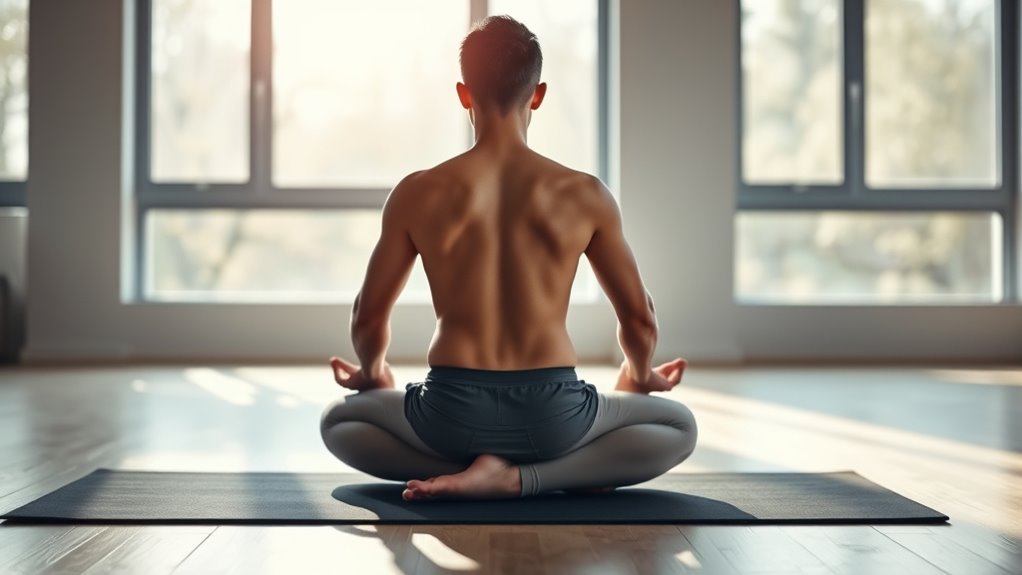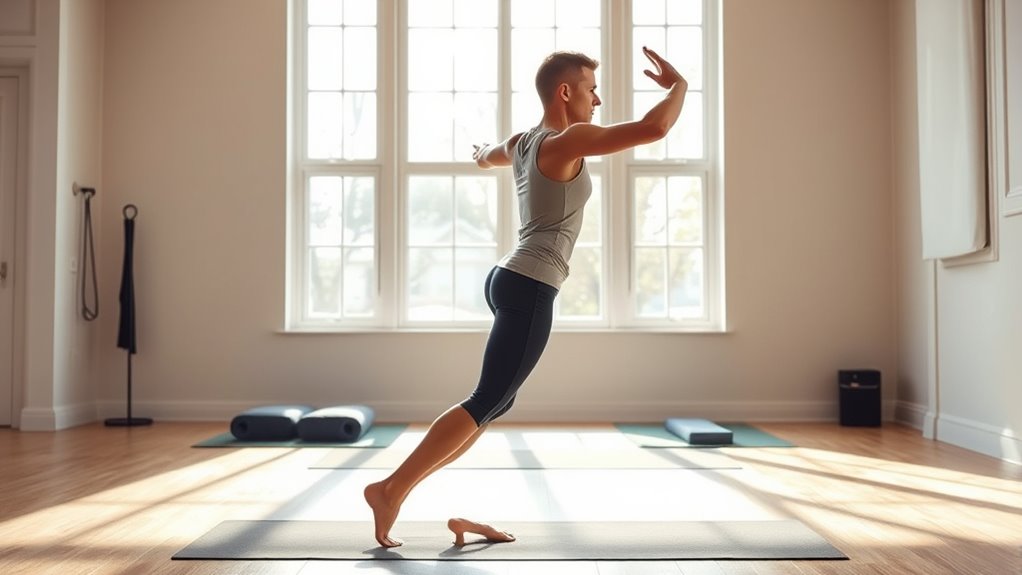To master posture basics in a weekend, start by evaluating your current alignment, noticing common issues like rounded shoulders or forward head. Focus on maintaining a neutral spine, engaging your core, and aligning your ears over shoulders. Practice breathing techniques, incorporate simple stretches, and adjust your workspace ergonomically. Use cues like mirrors or notes to remind yourself during sessions, and stay mindful of movement. Keep practicing these tips consistently, and you’ll build better habits—more insights await as you continue.
Key Takeaways
- Conduct a quick posture assessment and identify common misalignments to set a baseline for correction.
- Practice maintaining neutral spine, engaged core, and proper alignment during all activities.
- Use visual cues, mirrors, or reminders to reinforce correct posture habits consistently.
- Incorporate breathing exercises and gentle stretches to support muscle balance and awareness.
- Monitor progress through regular checks and make small adjustments for sustained improvement.
Assess Your Current Posture and Identify Common Issues

Before you can improve your posture during sessions, it’s essential to assess your current stance. A posture assessment helps you identify how you hold yourself and spot common misalignments. Stand in front of a mirror or ask someone to observe your posture from the side and front. Look for signs of rounded shoulders, uneven hips, or a forward head position. Notice if your weight shifts more to one side or if your back curves excessively. Recognizing these issues early allows you to target specific areas for correction. Pay attention to how your body feels in this position—any discomfort or tightness indicates misalignments. Being aware of these common misalignments provides a solid foundation for making meaningful improvements during your posture training.
Understand the Principles of Proper Alignment

A solid understanding of proper alignment is essential for maintaining healthy posture during sessions. Your goal is to keep your spinal alignment neutral, preventing strain and discomfort. This involves balancing muscle groups so no area is overworked or weak. When your muscles are in proper balance, your spine stays aligned naturally, reducing stress on joints and tissues. Focus on stacking your ears over your shoulders and hips over your ankles, ensuring your head isn’t forward or tilted. Engaging your core helps support this alignment and maintains stability. Remember, good posture isn’t just about standing tall—it’s about aligning your spine correctly and keeping muscles balanced to support that position effortlessly. Mastering these principles sets a strong foundation for lasting postural habits. Incorporating muscle balance into your routine ensures your posture remains sustainable and comfortable over time.
Practice Breathing Techniques to Support Good Posture

Practicing diaphragmatic breathing helps you engage your core muscles and maintain better posture. Focus on maintaining a consistent rhythm to make this technique more effective throughout your sessions. When you breathe deeply and evenly, you’ll support your body’s alignment naturally. Incorporating GMC tuning principles can also help optimize your body’s posture and performance during sessions.
Diaphragmatic Breathing Practice
To support good posture during sessions, mastering diaphragmatic breathing is essential. This technique involves taking deep abdominal breaths that engage your diaphragm, helping you stay calm and aligned. Focus on breathing slowly through your nose, allowing your belly to rise as you inhale and fall as you exhale. Practicing diaphragmatic breathing regularly can reduce tension and improve your posture naturally. Remember these key points:
- Breathe deeply into your stomach, not your chest
- Maintain relaxed shoulders during each breath
- Inhale through your nose for better oxygen flow
- Exhale fully to release tension in your core
- Incorporating automation technologies can further support consistent practice and enhance your overall posture routine.
Incorporating deep abdominal breaths helps you stay centered and upright, supporting ideal posture during long sessions. Consistent practice makes this technique second nature.
Maintain Consistent Rhythm
Maintaining a consistent breathing rhythm is essential for supporting good posture during sessions. When your breath stays steady, your posture awareness improves, helping you stay aligned and focused. Consistent practice of breathing techniques keeps your muscles relaxed and reduces tension that can lead to slouching. To visualize this, consider the following:
| Inhalation | Pause | Exhalation |
|---|---|---|
| Fill lungs slowly | Hold breath briefly | Release air smoothly |
| Maintain control | Keep posture upright | Relax shoulders |
| Repeat regularly | Focus on steady rhythm | Support posture stability |
Developing mindfulness through deep breathing exercises can further enhance your ability to maintain posture and reduce physical stress.
Incorporate Simple Stretching and Strengthening Exercises

Incorporating simple stretching and strengthening exercises into your routine can substantially improve your posture during sessions. These exercises help enhance core stability and shoulder mobility, which are crucial for maintaining proper alignment. Focus on movements that target these areas to prevent slouching and reduce strain. Engaging in regular posture-focused exercises can also reinforce good habits and support long-term spinal health.
Adjust Your Workspace for Optimal Ergonomics

Adjusting your workspace for ideal ergonomics is essential to support good posture throughout your sessions. Start by arranging your desk and chair so your feet rest flat on the floor and your knees are at a 90-degree angle. Use ergonomic accessories like lumbar supports and adjustable monitor stands to keep your spine aligned. Proper workspace lighting reduces eye strain and prevents you from leaning forward. Position your monitor at eye level, keeping your shoulders relaxed and wrists straight. Consider the following setup ideas:
| Aspect | Tips |
|---|---|
| Ergonomic Accessories | Use lumbar pillows, footrests, and monitor risers |
| Workspace Lighting | Opt for natural light or adjustable desk lamps |
| Monitor Placement | Keep at eye level, about an arm’s length away |
| Chair Adjustment | Set height so hips are slightly above knees |
Additionally, incorporating posture awareness throughout your sessions can help maintain ergonomic integrity and reduce discomfort.
Develop Mindful Posture Habits Throughout the Day

Once you’ve set up your workspace for ergonomic comfort, the next step is to cultivate awareness of your posture throughout the day. Practicing mindful awareness helps you recognize when your posture slips and enables you to make quick corrections. To build posture discipline, incorporate simple habits into your routine:
Stay mindful of your posture to prevent slips and stay comfortable all day long.
- Regularly check your alignment during breaks
- Take deep breaths to reset your focus
- Move and stretch every 30 minutes
- Keep a posture journal to track progress
- Consider using eye patches to reduce eye strain and maintain overall comfort during long periods at your desk.
Utilize Reminders and Cues to Reinforce Correct Posture

Using reminders and cues keeps you aware of your posture during sessions. You can set visual prompts, use verbal cues, or add physical prompts to reinforce proper alignment. These strategies help make good posture a consistent habit. Incorporating performance kits like ergonomic accessories can further support maintaining correct posture throughout your session.
Set Visual Reminders
Setting visual reminders can be a highly effective way to reinforce correct posture during sessions. Visual cues act as constant posture prompts, keeping you focused and mindful. You can use simple tools like sticky notes, posters, or mirrors to serve as quick visual triggers. These cues remind you to sit upright, relax shoulders, and engage your core. To maximize their effectiveness, place them where you’ll see them frequently, such as near your workspace or screen. Consistent exposure to these visual prompts helps create a habit of maintaining good posture. Remember, the key is making these cues easily noticeable and relevant, so your mind instinctively responds with proper alignment. Incorporating Visual cues into your routine can significantly improve your posture habits over time.
Use Verbal Cues
Verbal cues are a powerful way to reinforce good posture habits during sessions. Using verbal encouragement and cue phrasing helps remind you to maintain proper alignment. When you notice slouching, respond with simple cues like, “Sit tall,” or “Keep shoulders relaxed.” Consistent verbal reminders build awareness and reinforce habits. Consider using a table like this:
| Cue Phrase | Context | Benefit |
|---|---|---|
| “Stand tall” | During standing sessions | Improves overall posture |
| “Relax shoulders” | When tension builds | Reduces strain |
| “Engage core” | When posture slips | Supports spine |
Repeating these cues fosters muscle memory, making good posture second nature during your sessions. Incorporating posture awareness techniques can further enhance your ability to maintain proper alignment effortlessly.
Incorporate Physical Prompts
Incorporating physical prompts into your sessions can effectively reinforce correct posture by providing tangible reminders. These physical prompts help increase your posture awareness and serve as cues to correct alignment when needed. You can use simple tools or gestures to remind yourself to maintain good posture. For example, consider using:
- A small mirror to check your alignment regularly
- Sticky notes placed in view as visual cues
- A gentle tap on your shoulder to prompt upright sitting
- Wearing a posture-correcting device as a physical reminder
These physical prompts act as cues that reinforce healthy habits, making it easier to stay aware of your posture throughout your sessions. Consistently using them helps engrain correct posture as a natural part of your routine.
Practice Posture During Movement and Exercise Routines

Practicing good posture during movement and exercise routines is essential for preventing injury and maximizing effectiveness. When you focus on maintaining proper alignment, you enhance core stability, which supports your entire body. Incorporate balance exercises to build stability and awareness during dynamic movements. Pay attention to your form during activities like walking, lunging, or lifting, ensuring your back stays straight and shoulders relaxed. Using the table below, you’ll see how different exercises benefit from proper posture:
| Exercise Type | Posture Focus |
|---|---|
| Balance exercises | Engage core, keep hips level |
| Dynamic movements | Maintain neutral spine |
| Strength routines | Avoid overextension or hunching |
| Flexibility routines | Keep joints aligned |
Consistent practice helps embed good habits, enhancing your overall posture during movement.
Track Your Progress and Make Adjustments as Needed

Monitoring your posture during movement and exercise routines helps you identify what’s working and where improvements are needed. Posture tracking allows you to see patterns and spot deviations that need correction. Once you have data, you can apply adjustment strategies to fine-tune your posture effectively. To get the most out of this process:
- Regularly review your posture logs or recordings
- Focus on recurring issues to address with targeted exercises
- Gradually implement small, manageable adjustments
- Reassess your posture after each change for progress
Frequently Asked Questions
Can Posture Improvement Be Maintained Without Ongoing Practice?
Posture improvement can be maintained without ongoing practice if you integrate ergonomic gadgets and good daily habits into your routine. When you consistently use ergonomic chairs, adjustable desks, and take regular breaks, you reinforce proper alignment. By consciously maintaining these habits, your posture becomes more natural over time, reducing the need for constant effort. Remember, consistency is key—small, daily adjustments help sustain your posture improvements long-term.
What Are Signs of Poor Posture That Need Immediate Correction?
If you notice persistent neck pain, rounded shoulders, or lower back discomfort, these are signs of poor posture needing immediate correction. To address this, make ergonomic adjustments to your workspace and focus on muscle strengthening exercises. Regularly checking your alignment and practicing proper ergonomics can prevent strain. Staying mindful of these signs helps you correct posture quickly, reducing discomfort and promoting long-term musculoskeletal health.
How Long Does It Typically Take to See Posture Improvements?
You can usually see posture improvements within a few weeks if you consistently make ergonomic adjustments and focus on muscle strengthening. By actively practicing good habits and correcting your posture during sessions, you’ll notice less discomfort and better alignment. Keep in mind, progress varies based on your starting point and dedication, but with regular effort, you’ll develop better posture faster. Stay committed, and the results will follow.
Are There Specific Exercises Suitable for All Age Groups?
Yes, there are exercises suitable for all age groups. You can incorporate simple balance exercises to improve core stability, regardless of age. Using ergonomic furniture helps maintain proper posture during daily activities. For seniors, gentle stretching and seated balance exercises work well, while younger individuals can do more dynamic movements. Always adapt exercises to your comfort level and consult a professional if needed to guarantee safety and effectiveness.
How Do I Correct Posture While Using Mobile Devices?
To correct your posture while using mobile devices, start by increasing your posture awareness. Use ergonomic accessories like phone stands or grips to keep your device at eye level, reducing neck strain. Take regular breaks, stretching your neck and shoulders, and avoid slouching. Maintain a neutral spine position, and stay mindful of your posture throughout the day. These simple steps help prevent discomfort and promote better habits.
Conclusion
By dedicating a weekend to mastering your posture, you’re channeling the discipline of a sculptor shaping marble, transforming your habits with mindful effort. Remember, like a steady lighthouse guiding ships through fog, consistent practice and awareness keep you aligned and balanced. Embrace these tips, and over time, your posture will become as natural as the tide’s pull—an enduring affirmation to your commitment and self-care.









